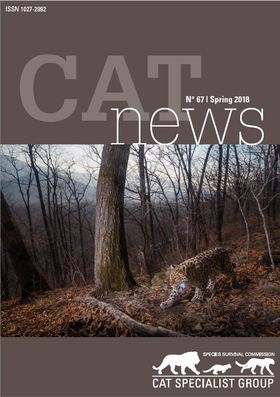Editorial

- Fig. 1. Symbol of the World Wildlife Day projected on the Heiliggeistkirche, Bern (Photo Starlight Events GmbH).

- Fig. 2. Speakers and some participants of the big cat symposium organised by the Cat SG, FSVO, FOEN, FDFA and Innflow AG in Bern for the World Wildlife Day 2018 (Photo M. Pittet).

- Fig. 3. Picture of cheetahs projected on the Heiligeistkirche, Bern (Photo Starlight Events GmbH).
World Wildlife Day 2018
On 20 December 2013, at its 68th session, the UN General Assembly proclaimed 3 March – the day of signature of the Convention on International Trade in Endangered Species of Wild Fauna and Flora CITES – as UN World Wildlife Day. This day was proclaimed to celebrate and raise awareness of the world’s wild animals and plants. The theme of WWD18 (Fig. 1) was “Big cats: predators under threat”.The IUCN/SSC Cat Specialist Group Cat SG joint up with the Swiss governmental agencies in charge of CITES and the Convention on Migratory Species CMS to celebrate WWD18 in Bern. On the 3 March 2018 afternoon, the Cat SG, together with the Federal Food Safety and Veterinary Office FSVO, the Federal Office for the Environment FOEN, the Federal Department of Foreign Affairs FDFA, and the private company Innflow AG, organised a symposium where several of the big cats and global instruments for their conservation were presented. We had an amazing panelof speaker (Fig. 2): The Symposium was introduced by Claude Martin, former Director General WWF International. Luke Hunter (President Panthera) presented priorities for lion conservation. Juan Carlos Vasquez (Legal Affairs and TradePolicy Unit of the CITES Secretariat) and Mathias Lörtscher (FSVO and Chair of the CITES Animal Committee) introduced the Washington Convention as an instrument for supporting the conservation of cats. Dale Miquelle (WCS) gave a most entertaining on the tiger as the top cat predator. Sugoto Roy (IUCN) introduced the Integrated Tiger Habitat Conservation Programme. Hadi Al Hikmani (Office for Conservation of the Environment,Diwan of Royal Court, Oman) talked about the struggle for keeping the Arabian leopard alive. Tabea Lanz (IUCN/SSCCat Specialist Group Red List Authority Coordinator) explained the role of the IUCN Red List of Threatened Species. Leili Khalatbari (CIBIO, University of Porto) introduced the Asiatic cheetah, the world’s rarest cat, and Tanya Rosen (Panthera) the wold’s most mystic cat, the snow leopard. Sabine Herzog (FOEN) and Bradnee Chambers (Executive Secretary of the CMS) presented the Bonn Convention and its Central Asian Mammals Initiative CAMI. Lucas Leuzinger, farmer and conservationist, gave a practical example on the conservation of jaguars in the Pantanal. Reinhard Schnidrig (Head of Wildlife and Forest Biodiversity Section, FOEN) explained the conservation and management of Switzerland’s largest cat,the Eurasian lynx. The symposium was attended by some 200 people interested in cat conservation. The presentations will be summarised in a Special Issue of Cat News. In the late afternoon of the 3 March, the celebration continued with a “market of chances” exhibition and a podiumdiscussion in the Heiliggeistkirche. In the discussion, Doris Calegari (WWF Switzerland), Christine Breitenmoser (Cat SG),Reinhard Schnidrig (FOEN) and Mathias Lörtscher (FSVO) discussed with moderator Kathrin Naegeli (FSVO) the challenges of conserving big cats in a human-dominated world. Finally, a large-scale slide show projected to the Heiliggeistkirche,one of the big churches of Bern, showed the fascination of the big cats to a broad public (Fig. 1 & 3).
Urs Breitenmoser
Records of pumas scavenging at jaguar kills in Santa Rosa National Park, Costa Rica by L. G. Fonseca, S. Arroyo-Arce, I. Thomson, W. N. Villachica and R. A. Valverde
This study describes records of scavenging behaviour of pumas Puma concolor at jaguar Panthera onca kills in Costa Rica. We set camera traps at fresh carcasses predated by jaguars on Nancite beach between March 2010 and July 2017. Pumas were recorded at four out of 70 monitored kills. Jaguars interacted with the carcasses mainly at night while pumas were more active during the day. Since little is known about pumas using jaguar kills as food resource it is important to continue our monitoring efforts to better understand this interaction.
Supporting Online Material
Arabian sand cats in 'Uruq Bani Ma'arid reserve, Empty Quarter of Saudi Arabia by M. Zafar ul-Islam, H. Al Qahtani and M. Aldosari
The sand cat Felis margarita is an elusive species, with limited information on its distribution, habitat use and ecology in the wild. In Saudi Arabia the species is recorded in various areas but there is little information from the southern Empty Quarter. Camera trapping studies were carried out in the large Empty Quarter in the protected area ‘Uruq Bani Ma’arid between 2015 and 2017. Seventeen infrared Bushnell camera traps were installed at various locations in Uruq. Twenty pictures of sand cats were taken at 11 out of 17 camera trap stations. There was no obvious geographical pattern, but further studies may illuminate drivers of sand cat distribution. The species is vulnerable to indiscriminate trapping and poisoning of predators. We propose to conduct systematic surveys in more areas throughout Saudi Arabia to study the conservation status of this ecologically important species.
Transboundary leopard movements between Azerbaijan and Iran in the Southern Caucasus by E. Maharramova, E. M. Moqanaki, E. Askerov, S. Faezi, H. Alinezhad, M. Mousavi, T. Kuemmerle, A. Heidelerg and N. Zazanashvili
Understanding whether large cat populations are transboundary by nature is important for conservation planning. We here report transboundary movement by an adult male Persian leopard Panthera pardus tulliana (= P. p. ciscaucasica = P. p. saxicolor) in the Talysh Mountains of the south-eastern Lesser Caucasus. Between 12 and 13 July 2013 this leopard, named Astkhan, was photographed by camera traps at three locations inside Hirkan National Park NP, Talysh Mountains,Azerbaijan. On 7 February 2014 a local hunter killed an adult leopard in Chubar Highlands of Gilan Province, north-western Iran, approximately 30 km away from Hirkan NP (straight-line distance). Comparing photos of this poached leopard with those obtained from Hirkan NP allowed us to identify this leopard as Astkhan. This is the first hard evidence of transboundary movements by Persian leopards in the Talysh Mountains, and thus for linkages between leopard sub-populations in Azerbaijan and northern Iran. This also suggests that the transboundary Talysh Mountains are of utmost importance as a corridor between core leopard areas in the Caucasus Ecoregion, and thus for the Persian leopard conservationin general. Joint survey planning, reporting and data sharing can be a first step for transboundary cooperation in leopard conservation between the eco-regional countries.
Supporting Online Material
The illegal use of snares and gin traps threatens endangered leopards in Iran by I. Memarian, S. Ostrowski, H. Kordestani, F. Khakpour and N. Pouyanshad
We report on six cases of snare and gin trap captures of free-ranging Persian leopards Panthera pardus tulliana in northern Iran between 2012 and 2017. Three of these leopards died as result of severe injuries, the three others were rescued, one survived albeit disabled, two could be released to the wild but one of them died less than two months after release. These captures were unintentional, and resulted from snares and gin trap being deployed illegally by farmers to rid their crops and chicken-coop from wild boars Sus scrofa (5) and possibly jackals Canis aureus / jungle cats Felis chaus (1), respectively. These cases reveal the growing problem of habitat dis-turbance and loss for leopard and their natural prey in the Alborz mountain range and Caspian lowlands of Iran.
Supporting Online Material
Two Amur leopards come into captivity in Russia in 2015 by E. Y. Blidchenko, N. Sulikhan, E. I. Shevtsova, A. V. Vitkalova, P. L. Sonin, V. B. Kuzmenko, D. S. Matyukhina, M. Gilbert, M. V. Alshinetskiy, S. V. Naidenko and D. G. Miquelle
Amur, or Far Eastern leopards Panthera pardus orientalis, rarely come into captivity,but in 2015, two animals were brought to the TRNGO Rehabilitation Centre in the Russian Far East. One animal was confirmed to have canine distemper, the first such documentation for this subspecies in the wild, and was eventually euthanized. Analyses of archived serum samples revealed there have been earlier exposures of the population to canine distemper. A male leopard brought into captivity was compromised by the loss of three toes, but with veterinary care he recovered, developed excellenthunting skills and seemed like a candidate for release back to the wild. However, icy conditions resulted in complications to the wounded paw, and a decision was made to retain him in captivity as part of the EAZA Amur leopard breeding programme.
Common leopard and snow leopard co-existence in Sanjiangyuan, Qinghai, China by S. Mei, J. S. Alexander, X. Zhao, C. Cheng and Z. Lu
The snow leopard Panthera uncia, classified as Vulnerable by the IUCN, is distributed across the mountainous areas of 12 countries in South and Central Asia. The common leopard Panthera pardus, also classified as Vulnerable by the IUCN, has the widest geographic distribution among all wild cats and inhabits many countries of Africa and Asia. The common leopard is much bigger than the snow leopard. Sightings of both species in the same location have recently been reported from the Autonomous Region of Tibet and Sichuan, China. We conducted a camera trap survey to verify the presence of these large carnivores using camera traps in Niandu and Yunta villages of Qinghai province, China. In both areas camera trap stations captured both species, identifying seven adult snow leopard and four adult common leopard individuals. Our study provides the first photographic evidence of common leopard presence in Qinghai province and confirms the co-existence of snow leopards and common leopardsin the Sanjiangyuan National Nature Reserve. A more detailed study will be conducted to investigate the distribution and interaction of the two species along Tongtianhe and Zhaqu rivers, Qinghai province, in order to enhance efforts for their long-term conservation.
Behavioural observations on interaction of leopard and striped hyena, western India by D. Mandal, D. Chatterjee, Q. Qureshi and K. Sankar
Interspecific interactions are crucial for community composition since they govern species distribution, abundance and broadly species coexistence. Interspecific interactions among carnivores have been well studied in India. However, these were limited to a few species only and direct observations are rare. Studies on interspecific interaction between two sympatric carnivores such as leopard and striped hyena with a wide distribution range throughout peninsular India are rare. We report two instances of interactions between leopard Panthera pardus and striped hyena Hyaena hyaena. In one instance, a leopard and a striped hyena were photographed feeding together on an adult nilgai Boselaphus tragocamelus kill of a tigress Panthera tigris. We have also recorded a breeding female leopard that killed a striped hyena (sub-adult female) at a densite. We report here photographic evidence on these interactions between leopard and striped hyena for the first time.
Supporting Online Material
Mating behaviour of Indian leopard by K. Trivedi & K. Mody
Mating behaviour of leopard Panthera pardus has been rarely observed in the wild. We have been able to observe and document leopard mating in a fallow field of an agricultural farm in Surat district, Gujarat, India, in May 2016. The mating behaviour was filmed with a camera trap during six days. After this, the female left the area while the male was observed for another few days.
Supporting Online Material
Monsters or Gods? Narratives of large cat worship in western india by V. Athreya, S. Pimpale, A. S. Borkar, N. Surve, S. Chakravarty, M. Ghosalkar, A. Patwardhan and J. D. C. Linnell
In this article we describe the belief in the presence of a large cat diety; Waghoba, which appears to be geographically widespread in western India and is still revered today. It is a very old cultural institution which according to many interviewees was at least many centuries old. The people had a deep belief that the large cat; a leopard Panthera pardus or a tiger Panthera tigris or both, protected them. This ancient cultural connection between people and large cats is little studied or understood. Believers also have an understanding of the ecology of the animal as well as their own myths surrounding the animals. We address the rarely acknowledged, but probably deeply relevant, cultural context where groups of people have a radically different relationship with large cats which is largely ignored by conservationists. These relationships could provide the basis for co-adaptations that allow for coexistence in shared landscapes, therefore, it is very important that we document and study these institutions before they die out.
Supporting Online Material
First picture and temporal activity of rusty-spotted cat from Chhattisgarh, Central India by K. Basak, M. Ahmed, M. Surfaj, C. Sinha, B. V. Reddy, O. P. Yadav and K. Mondal
We report here on the first camera trap pictures of the rusty-spotted cat Prionailurus rubiginosus from Udanti-Sitanadi Tiger Reserve USTR, State of Chhattisgarh, India. During our tiger monitoring programme from December 2016 to April 2017 we obtained 29 camera trap pictures of rusty-spotted cats at elevations between 353 and 924 m. Previously, there were no photographic evidences corroborating the presence of this species in the State of Chhattisgarh. Several human communities like Kamar, Bhunjia, Muriya, Gond and others residing in and around the tiger reserve, are known to prevalently hunt herbivores along with small carnivores for occasional consumption. Anecdotal information collected from remote forest villages indicated that rusty-spotted cat could potentially be threatened by this illegal hunting. More research is needed to understand the ecology of rusty-spotted cat including their population status, threats and required habitat parameters in the area. This information would help to improve the management and conservation in USTR.
Supporting Online Material
Photographic record of rusty-spotted cats in Tipeshwar Wildlife Sanctuary, India by P. Hushangabadkar, J. Jena, J. Borah, S. Dey and M. S. Reddy
The rusty-spotted cat Prionailurus rubiginosus is one of the world’s smallest wild cat species, living in South Asia. In Central India, the species has already been recorded in Tadoba-Andheri and Navegaon Nagzira Tiger Reserves. Here we report the first camera trap pictures of rusty-spotted cat from Tipeshwar Wildlife Sanctuary TWS in Yavatmal District, Maharashtra, India.
Feeding behaviour of fishing cat in the Godavari mangroves, India by G. Malla, P. Ray and K. Sivakumar
We observed a rare feeding behaviour of a fishing cat Prionailurus viverrinus on a dog-faced water snake Cerberus rynchops and pond heron Ardeola grayii in the mangroves of the Godavari delta in India. Since fishing cats are threatened due to various levels of anthropogenic pressure, these observations giving insight into their behaviour highlight the need to study these elusive cats.
Fishing cat camera trapped in Babai Valley of Bardia National Park, Nepal by S. K. Yadav, B. R. Lamichhane, N. Subedi, M. Dhakal, R. K. Thapa, L. Poudyal and B. R. Dahal
Fishing cats Prionailurus viverrinus are globally threatened. Recent surveys suggest further decline of their populations throughout their range. In Nepal, their status is poorly known. However, due to increasing intensity of camera trap surveys, fishing cats were recorded in different protected areas in recent years. In Bardia National Park BNP of western Nepal, we recorded 15 photos (10 left and 5 right flanks) of fishing cats during a camera trap survey targeted at tigers in winter 2016/2017. Solitary fishing cats were camera trapped at a single location in Babai valley of Bardia during two events within a week. Fishing cat was supposed to exist in Bardia but this is the first conclusive evidence with photographs.
Supporting Online Material
Eurasian lynx and Pallas's cat in Dolpa district of Nepal: genetics, distribution and diet by G. Werhahn, N. Kusi, D. Karmacharya, A.M. Sherchan, P. Manandhar, S. Manandhar, T.R. Bhatta, J. Joshi, S. Bhattarai, A.N. Sharma, J. Kaden, M. Ghazali & H. Senn
The Eurasian lynx Lynx lynx and the Pallas’s cat Otocolobus manul are elusive felids which are little studied in the Himalayas of Nepal where they seem to occur at low densities. We present mtDNA genomic and dietary data of six Eurasian lynx scats and one Pallas’s cat scat collected in Dolpa district of Nepal. The Eurasian lynx scats were found in alpine shrub lands at elevations from 4,738 - 4,818 m. Dietary analysis based on microscopic frequency of occurrence revealed that the six Eurasian lynx scats contained 56 % woolly hare Lepus oiostolus, 17.7 % pika Ochotona sp. and rodent Alticola sp., 9.7 % Himalayan marmot Marmota himalayana, 7 % vegetation and 3.3 % domestic goat Capra aegagrus hircus. The Pallas’s cat scat found in a rocky boulder field contained 76 % pika hair, 18 % woolly hare hair and 4 % vegetation. This study provides the first scientific record of Eurasian lynx in Shey-Phoksundo National Park SPNP. The finding on Pallas's cat represents an expansion of the IUCN distribution range in Nepal, presents the second locality record of the species in the country, and with the sample collected at 5,539 m is the highest elevation record for the species to date. Further researches into population status, ecology, genetics and conservation of these elusive felids in the Himalayas are recommended.
Occurrence of six felid species outside protected areas in Bhutan by T. Dhendup and R. Dorji
We report the presence of six of the eleven wildcat species found in Bhutan: tiger Panthera tigris, common leopard Panthera pardus, clouded leopard Neofelis nebulosa, Asiatic golden cat Catopuma temminckii, marbled cat Pardofelis marmorata and leopard cat Priornailurus bengalensis from Gedu Territorial Forest Division. This is the first published record of six felid species in a territorial forest division, and the finding suggests that landscapes outside protected areas are equally promising and important for wild felid conservation in Bhutan. We call for increased monitoring, dedicated surveys and sustainable forest management practices in the divisions.
A note on felid trade at local markets in Myanmar by S. Min, N. D'Cruze and D. W. Macdonald
With its biogeographic position, its multiple international borders and changing political circumstances, Myanmar is a country of on-going felid conservation priority. To complement pre-existing longer term illegal wildlife trade studies, we initiated a short scoping survey focused on five study sites including those located in the interior of Myanmar (Kyaiktiyo, Mandalay and Min Bu Shwe Sat Taw) and along the Thailand border (Myawaddy and Tachileik). We confirm notable ongoing open trade in at least six species of Asian felids (jungle cat Felis chaus, clouded leopard Neofelis nebulosa, leopard Panthera pardus, tiger Panthera tigris, Asiatic golden cat Catopuma temminckii and leopard cat Prionailurus bengalensis) at three of these study sites (Kyaiktiyo, Min Bu Shwe Sat Taw and Tachileik). With regard to field skins, we found tiger to be the most expensive (1,100 $USD) and jungle cat to be the cheapest species available (11 $USD). However, full felid skins (and full skulls) derivedfrom clouded leopard were most commonly observed, supporting pre-existing concerns that this species is under particular pressure from poaching in Myanmar. Based on our findings, we support calls for increased donor support for research into illegal felid trade dynamics in Myanmar and for improved cooperation between national and international enforcement agencies on CITES to help conserve remaining wild populations.
Supporting Online Material
Obituary
Bernardino Ragni
IUCN SSC Cat Specialist Group Member
Professor of Zoology and Wildlife Management at University of Perugia
On 16 January 2018 Professor Bernardino Ragni left us aftera brief but devastating illness. 'Dino' was a great scholar of the felids, zoology of vertebrates, conservation biology, and wildlife management, who had devoted his whole life to research and teaching at the University of Perugia. When I started my study and research in the late 1970s, I became interested in the study of Felis silvestris, one of my totemic species, about which very little was known in Italy. So I came across Dino, the only one who had then studied this interesting species, which had been the subject of hisgraduation thesis in the late 1960s. I tried to contact himmore than once, but at that time it was not easy to communicate with him; he was in fact a bit shy and not inclined to collaborations, perhaps because of the strong and unjustified competition between many Italian universities. His works on the European wildcat were many and fundamental. Memorable, among others, was his systematic work together with Ettore Randi and others, which laid the foundations of the systematics based on the existence of only one polytypic species, represented by European wildcat Felis silvestris silvestris, North African wildcat (including alsothe Sardinian cat) Felis silvestris lybica, and domestic cat Felis silvestris catus. Although lately another taxonomic and nomenclatural situation has been proposed, which partly brings back previous point of view (see Kitchener et al. 2017. A revised taxonomy of the Felidae. Cat News Special Issue 11), the systematic of B. Ragni and E. Randi was taken as areference by all scholars for at least 30 years. Dino was also involved in lynx work in the Alps. Together with M. G. Possentiand S. Mayr, he described a subspecies Lynx lynx alpina, which possibly has, due to the clearly distinct characteristics ofthe historic specimens of the now extinct original Alpine population, its systematic and phylogenetic validity and would deserve further biomolecular investigations. Lately he had written an interesting book on the 'Wildlife Economy' i.e. on the sustainable use of fauna in a context of human-wildlife compatibility and coexistence.Over the past decade, I finally managed to establish contact with Dino, and this was a surprising experience in a positive sense. I discovered a great and extremely accessible person, someone I never would have imagined based on my previous experiences with him. Very friendly, and always ready to give advice and also to listen to the opinion of others, with greathumility and correctness. I am immensely sorry not to have been able to get to know and appreciate him much earlier. Ifeel that I lost a big chance. We often disagreed over specific points, but this never detracted from the great mutual respect that existed between us. In the last years a friendship was born, too, that we both felt even though we did not see each other very often. Last year, he was preparing two contributions to be included in the book 'Problematic Wildlife II', oneabout 'Wildlife Economy'. Although he was not able to complete the work, I will make sure that it will be printed, as Dinohas asked me. The second contribution, on the problem of hybridization between European wildcats and domestic cats, we intended to write together. Regrettably, I do not think it will be possible to finish this work without Dino. Before Christmas 2017, I was still talking to him. Dino hinted at some health problems in general, with great dignity and control, and I never imagined that the problems were so serious. The news ofhis disappearance found me totally unprepared and he literally upset me, justnow as we were really friends and that I was fully appreciating him for his great scientific and human values! Author of more than 160 articles and scientific contributions, Bernardino Ragnihas been a member of the IUCN SSC Cat Specialist Group for thirty years, and has always been the leader and reference point of every cat scientist in Italy.‘Thank you, Dino for everything you did and for what you gave us, surely we willnever forget you and your name will always be associated with that of the shy(like you), wonderful and mysterious European wildcat!
Francesco Maria Angelici
FIZV, Via Marco Aurelio 2, I-00184 Roma, Italy. email: francescomariaangelici@gmail.com

- Fig. 1. 4 April 1963; Bernardino Ragni (the first from the left) in a boy scout camp. His interest in nature and the environment has always been present.

- Fig. 2. Prof. Bernardino Ragni in his late years (Photo C. Fabrizi)


